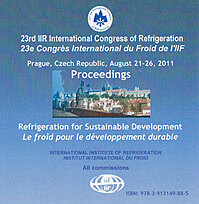
IIR document
Two-phase fluid network model for steady-state and dynamic simulation of multi-unit air conditioners.
Number: pap. ID: 425
Author(s) : SHAO S. Q., XU H. B., TIAN C. Q.
Summary
An integrated simulation model was developed to investigate the steady-state and dynamic performance of multi-unit air conditions (MUACs). It is built with the framework of two-phase fluid network which is able to describe different systems by incidence matrixes. And the submodels are embedded in the system framework, where the submodels can be either steady-state or dynamic model, distributed parameter or lumped parameter model. For this case, the numerical submmodels are employed such as moving-boundary condenser and evaporator models, steady-state models of compressor and electronic expansion valve. The model was validated by the data of a MUAC with four indoor units, which showed that the model can predict not only the steady-state performance, but also catch the dynamic trends of the MUAC with high accuracy, for example, the differences of evaporating pressure <±4%, condensing pressure <±3%, compressor discharge temperature <±4°C, superheating degree <±2°C, and subcooling degree <±1°C. Therefore, it was confirmed that the proposed simulation model is an effective tool to analyze the steady and transient characteristics and optimize system design and the control algorithm of MUACs.
Available documents
Format PDF
Pages: 8 p.
Available
Public price
20 €
Member price*
Free
* Best rate depending on membership category (see the detailed benefits of individual and corporate memberships).
Details
- Original title: Two-phase fluid network model for steady-state and dynamic simulation of multi-unit air conditioners.
- Record ID : 30002996
- Languages: English
- Source: Proceedings of the 23rd IIR International Congress of Refrigeration: Prague, Czech Republic, August 21-26, 2011. Overarching theme: Refrigeration for Sustainable Development.
- Publication date: 2011/08/21
Links
See other articles from the proceedings (569)
See the conference proceedings
Indexing
-
Air-water two-phase flow distribution in a mani...
- Author(s) : JEONG J., HAM S., CHOI S.
- Date : 2019/08/24
- Languages : English
- Source: Proceedings of the 25th IIR International Congress of Refrigeration: Montréal , Canada, August 24-30, 2019.
- Formats : PDF
View record
-
Development of a refrigerant two-phase flow dis...
- Author(s) : NAKAYAMA M., SUMIDA Y., HIRAKUNI S., et al.
- Date : 2000/07/25
- Languages : English
- Source: Proceedings of the 2000 International Refrigeration Conference at Purdue.
View record
-
Some modelling improvements for unitary air con...
- Author(s) : SHEN B., BRAUN J. E., GROLL E. A.
- Date : 2006/07/17
- Languages : English
- Source: 2006 Purdue Conferences. 18th International Compressor Engineering Conference at Purdue & 11th International Refrigeration and Air-Conditioning Conference at Purdue [CD-ROM].
- Formats : PDF
View record
-
Investigation of transient two-phase flow durin...
- Author(s) : HEDRICK M. J., JASSIM E. W., NEWELL T. A.
- Date : 2006/07/17
- Languages : English
- Source: 2006 Purdue Conferences. 18th International Compressor Engineering Conference at Purdue & 11th International Refrigeration and Air-Conditioning Conference at Purdue [CD-ROM].
- Formats : PDF
View record
-
Experimental study of two-phase adiabatic flow ...
- Author(s) : POGGI F., MACCHI-TEJEDA H., MARECHAL A., et al.
- Date : 2007/08/21
- Languages : English
- Source: ICR 2007. Refrigeration Creates the Future. Proceedings of the 22nd IIR International Congress of Refrigeration.
- Formats : PDF
View record
